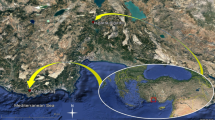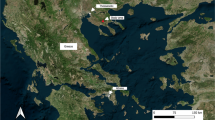Abstract
Thinning, as a forest management strategy, may contribute towards mitigating climate change, depending on its net effect on forest carbon (C) stocks. Although thinning provides off-site C storage (in the form of wood products) it is still not clear whether it results in an increase, a reduction or no change in on-site C storage. In this study we analyze the effect of thinning on C stocks in a long-term experiment. Different thinning intensities (moderate, heavy and unthinned) have been applied over the last 30 years in a Scots pine (Pinus sylvestris L.) stand, with a thinning rotation period of 10 years. The main C compartments were analyzed: above and belowground tree biomass, deadwood, forest floor and upper 30-cm of the mineral soil and tree biomass removed in thinning treatments. The results revealed that unthinned stands had the highest C stocks with 315 Mg C ha−1, moderate thinning presented 304 Mg C ha−1 and heavy thinning 296 Mg C ha−1, with significant differences between unthinned and heavily thinned stands. These differences were mainly due to C stock in live biomass, which decreased with thinning intensity. However, soil C stocks, forest floor and mineral soil, were not influenced by thinning, all of the stands displaying very similar values 102–107 Mg C ha−1 for total soil; 15–19 Mg C ha−1 for forest floor; 87–88 Mg C ha−1 for mineral soil). These results highlight the sustainability of thinning treatments in terms of C stocks in this pinewood afforestation, and provide valuable information for forest management aimed at mitigating climate change.

Similar content being viewed by others
References
Aussenac C (1987) Effets de l’eclaircie sur l’ecophysiologie des peuplements forestiers. Schweiz Z Forstwes 138:685–700
Assmann E (1970) The principles of forest yield study. Pergamon Press, Oxford
Bates D, Maechler M, Bolker B (2013) lme4: Linear mixed-effects models using S4 classes. R package version 0.999999-2. http://CRAN.R-project.org/package=lme4
Blanco JA, Imbert JB, Castillo FJ (2006) Influence of site characteristics and thinning intensity on litterfall production in two Pinus sylvestris L. forests in the western Pyrenees. Forest Ecol Manag 237(1–3):342–352
Blanco J, Imbert JB, Castillo F (2011) Thinning affects Pinus sylvestris needle decomposition rates and chemistry differently depending on site conditions. Biogeochemistry 106(3):397–414
Bravo F, Río M, Bravo-Oviedo A et al (2008) Forest management strategies and carbon sequestration. In: Bravo F, Jandl R, LeMay V, Gadow K (eds) Managing forest ecosystems: the challenge of climate change, vol 17. Springer, Netherlands, pp 179–194
Charro E, Gallardo J, Moyano A (2010) Degradability of soils under oak and pine in Central Spain. Eur J For Res 129(1):83–91
Chatterjee A, Vance GF, Tinker DB (2009) Carbon pools of managed and unmanaged stands of ponderosa and lodgepole pine forests in Wyoming. Can J For Res 39(10):1893–1900
Chroust L (1979) Thinning experiment in a Scots pine forest stand after 20 years investigation. Comm Inst For Chec 11:61–75
D’Amato AW, Bradford JB, Fraver S et al (2011) Forest management for mitigation and adaptation to climate change: insights from long-term silviculture experiments. Forest Ecol Manag 262(5):803–816
Díaz-Pinés E, Rubio A, Van Miegroet H et al (2011) Does tree species composition control soil organic carbon pools in Mediterranean mountain forests? Forest Ecol Manag 262(10):1895–1904
Fang JY, Wang ZM (2001) Forest biomass estimation at regional and global levels, with special reference to China’s forest biomass. Ecol Res 16(3):587–592
Froehlich HA, Miles DWR, Robbins RW (1985) Soil bulk density recovery on compacted skid trails in central Idaho. Soil Sci Soc Am J 49(4):1015–1017
Han HS, Page-Dumroese D, Han SK et al (2006) Effects of slash, machine passes, and soil moisture on penetration resistance in a cut-to-length harvesting. Int J For Eng 17(2):11–24
Herrero C, Bravo F (2012) Can we get an operational indicator of forest carbon sequestration?: a case study from two forest regions in Spain. Ecol Indic 17:120–126
Hoover C, Stout S (2007) The carbon consequences of thinning techniques: stand structure makes a difference. J Forest 105(5):266–270
Hothorn T, Bretz F, Westfall P (2008) Simultaneous inference in general parametric models. Biom J 50(3):346–363
Ibáñez JJ, Vayreda J, Gracia C (2002) Metodología complementaria al Inventario Forestal Nacional en Catalunya. In: Bravo F, Río M, Peso C (eds) El inventario forestal nacional. Elemento clave para la gestión forestal sostenible. Fundación General de la Universidad de Valladolid, Palencia, pp 67–77
IUSS (International Union Soil Science Working Group) (2007) World reference base for soil resources 2006. In: FAO (Ed.) World Soil Resources Reports 103. Roma, Italy
Jandl R, Lindner M, Vesterdal L et al (2007) How strongly can forest management influence soil carbon sequestration? Geoderma 137(3–4):253–268
Janssens IA, Sampson DA, Cermak J et al (1999) Above- and belowground phytomass and carbon storage in a Belgian Scots pine stand. Ann For Sci 56(2):81–90
Jonard M, Misson L, Ponette Q (2006) Long-term thinning effects on the forest floor and the foliar nutrient status of Norway spruce stands in the Belgian Ardennes. Can J For Res 36(10):2684–2695
Jurgensen M, Tarpey R, Pickens J et al (2012) Long-term effect of silvicultural thinnings on soil carbon and nitrogen pools. Soil Sci Soc Am J 76(4):1418–1425
Kaul M, Mohren G, Dadhwal V (2010) Carbon storage and sequestration potential of selected tree species in India. Mitig Adapt Strateg Glob Chang 15(5):489–510
Kramer H, Röös M (1989) Durchforstungsversuch in einem weitstaendig begruendeten Kiefernbestand (Thinning trial in a Scots pine stand established at wide spacing). Forst Holz 44(6):139–144
Lal R (2004a) Soil carbon sequestration impacts on global climate change and food security. Science 304(5677):1623–1627
Lal R (2004b) Soil carbon sequestration to mitigate climate change. Geoderma 123(1–2):1–22
MAGRAMA (Ministerio de Agricultura, Alimentación y Medio Ambiente) (2013) Infraestructura de datos espaciales. Available at: http://sig.magrama.es/geoportal. Cited 18 Feb 2013
Mäkinen H, Isomäki A (2004) Thinning intensity and growth of Scots pine stands in Finland. Forest Ecol Manag 201(2–3):311–325
Marland G, Schlamadinger B, Canella L (1997) Forest management for mitigation of CO2 emissions: how much mitigation and who gets the credits? Mitig Adapt Strateg Glob Chang 2(2–3):303–318
Nabuurs GJ, Masera O, Andrasko K et al (2007) Forestry. In: Metz B, Davidson OR, Bosch PR, Dave R, Meyer LA (eds) Climate change 2007: mitigation. Contribution of working group III to the fourth assesment report of the intergovernmental panel on climate change. Cambridge University Press, Cambridge, pp 541–584
Niles J, Schwarze R (2001) The value of careful carbon accounting in wood products. Clim Chang 49(4):371–376
Padilla FM, Vidal B, Sánchez J, Pugnaire FI (2010) Land-use changes and carbon sequestration through the twentieth century in a Mediterranean mountain ecosystem: implications for land management. J Environ Manag 91(12):2688–2695
Page-Dumroese DS, Jurgensen M, Terry T (2010) Maintaining soil productivity during forest or biomass-to-energy thinning harvests in the Western United States. West J Appl For 25(1):5–11
Pan Y, Birdsey RA, Fang J et al (2011) A large and persistent carbon sink in the world’s forests. Science 333(6045):988–993
Paul KI, Polglase PJ, Nyakuengama JG, Khanna PK (2002) Change in soil carbon following afforestation. Forest Ecol Manag 168(1–3):241–257
Peltola H, Miina J, Rouvinen I, Kellomaki S (2002) Effect of early thinning on the diameter growth distribution along the stem of Scots pine. Silva Fenn 36(4):813–825
Pérez-Cruzado C, Mansilla-Salinero P, Rodríguez-Soalleiro R, Merino A (2012) Influence of tree species on carbon sequestration in afforested pastures in a humid temperate region. Plant Soil 353(1–2):1–21
Post WM, Kwon KC (2000) Soil carbon sequestration and land-use change: processes and potential. Glob Chang Biol 6(3):317–327
Powers M, Kolka R, Palik B et al (2011) Long-term management impacts on carbon storage in Lake States forests. Forest Ecol Manag 262(3):424–431
R Development Core Team (2013) R: a language and environment for statistical computing. R Foundation for Statistical Computing, Vienna, Austria, URL http://www.R-project.org/
del Río M, Calama R, Cañellas I et al (2008) Thinning intensity and growth response in SW-European Scots pine stands. Ann For Sci 65:308
Río M, López-Senespleda E, Montero G (2006) Manual de gestión para masas procedentes de repoblación de Pinus pinaster Ait., Pinus sylvestris L. y Pinus nigra Arn. en Castilla y León. Serie Técnica. Junta de Castilla y León, Spain
Robinson AP, Wykoff WR (2004) Imputing missing height measures using a mixed-effects modeling strategy. Can J For Res 34(12):2492–2500
Roig S, Rio M, Cañellas I, Montero G (2005) Litter fall in Mediterranean Pinus pinaster Ait. Stands under different thinning regimes. Forest Ecol Manag 206(1–3):179–190
Ruiz-Peinado R, Bravo-Oviedo A, López-Senespleda E et al (2013) Do thinnings influence biomass and soil carbon stocks in Mediterranean maritime pinewoods? Eur J For Res 132(2):253–262
Ruiz-Peinado R, Río M, Montero G (2011) New models for estimating the carbon sink capacity of Spanish softwood species. For Syst 20(1):176–188
Schulp CJE, Nabuurs GJ, Verburg PH, de Waal RW (2008) Effect of tree species on carbon stocks in forest floor and mineral soil and implications for soil carbon inventories. Forest Ecol Manag 256(3):482–490
SECF (Sociedad Española de Ciencias Forestales) (2011) Situación de los bosques y del sector forestal en España. Informe 2010. 302 p. Available at: http://www.secforestales.org/web/images/inforestal2010.pdf. Cited: 22 Jun 2013
Simon G, Alberti G, Delle Vedove G et al (2012) Carbon stocks and net ecosystem production changes with time in two Italian forest chronosequences. Eur J For Res 131(5):1297–1311
Skovsgaard JP, Stupak I, Vesterdal L (2006) Distribution of biomass and carbon in even-aged stands of Norway spruce (Picea abies (L.) Karst.): a case study on spacing and thinning effects in northern Denmark. Scand J For Res 21(6):470–488
Valbuena-Carabaña M, López de Heredia U, Fuentes-Utrilla P et al (2010) Historical and recent changes in the Spanish forests: a socio-economic process. Rev Palaeobot Palynology 162(3):492–506
Valsta L, Lippke B, Perez-Garcia J et al. (2008) Use of forests and wood products to mitigate climate change. In: Bravo F, Jandl R, LeMay V, Gadow K (eds) Managing forest ecosystems: the challenge of climate change vol 17. Springer Netherlands 137–149
van Delft B, de Waal R, Kemmers R et al (2006) Field guide humus forms: description and classification of humus forms for ecological applications. Alterra, Wageningen
Vesterdal L, Dalsgaard M, Felby C et al (1995) Effects of thinning and soil properties on accumulation of carbon, nitrogen and phosphorus in the forest floor of Norway spruce stands. Forest Ecol Manag 77(1–3):1–10
Waddell KL (2002) Sampling coarse woody debris for multiple attributes in extensive resource inventories. Ecol Indic 1(3):139–153
Acknowledgments
We would like to thank to Eduardo López-Senespleda, Gerardo Urchaga and Antonio Urchaga for the field support and the staff of the INIA-CIFOR soil laboratory (Salvador Sastre and Puri Pereira) for their assistance. We also thank to all people who maintained the long term trial of this study. Adam Collins carried out the English revision. This work has been partially funded by the projects AGL2011-29701-C02-00, AT010-007 and AT013-004. We are grateful to the two anonymous reviewers for the suggestions that improved the final version of the manuscript.
Author information
Authors and Affiliations
Corresponding author
Rights and permissions
About this article
Cite this article
Ruiz-Peinado, R., Bravo-Oviedo, A., Montero, G. et al. ‘Carbon stocks in a Scots pine afforestation under different thinning intensities management’. Mitig Adapt Strateg Glob Change 21, 1059–1072 (2016). https://doi.org/10.1007/s11027-014-9585-0
Received:
Accepted:
Published:
Issue Date:
DOI: https://doi.org/10.1007/s11027-014-9585-0




